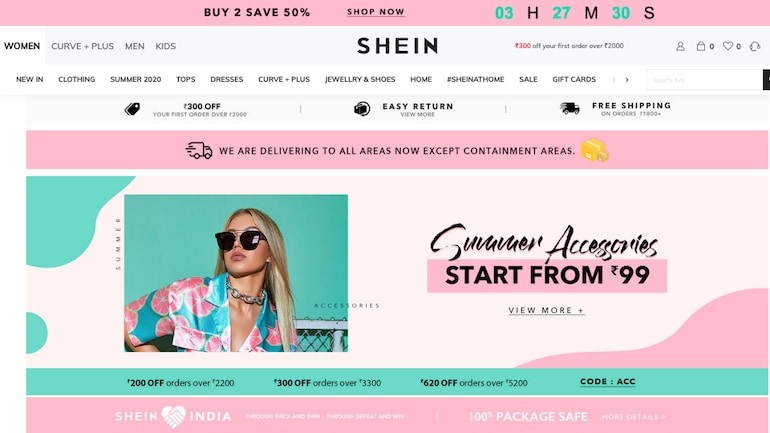

“Shein logo” by Shein.com is licensed under CC BY-SA 4.0.
Q: Do a case study of a platform business. When did the business commence, what are its primary fields of operation, and has it been successful? How does it make money from its activities, and have any concerns been raised about the company?
The central notion of the neoclassical economic analysis is the idea that “new technology is a potential engine of growth” and human behaviour is shaped by the “pursuit of the goals towards profit and individual satisfaction” (Mansell, et al., 2020). This notion suits well with digital platform operations in businesses. Shein is one of the top fast-fashion retailers in the world, worth of $15 billion (Alibaba.com, 2021). The company is based in China yet ships to over 220 countries and territories around the globe (Alibaba.com, 2021).
Shein’s commence date and their primary fields of operation
Shein was founded in 2008 by Chris Xu in Nanjing, China with the idea that fashion is accessible to everyone (Alibaba.com, 2021). Shein’s primary fields of operation is in women’s apparel and accessories, including tops, bottoms, dresses, bodysuits, etc. (Alibaba.com, 2021). Shein runs as a standard e-commerce store, where there are both desktop and mobile versions. E-commerce platform operations comprise of stocking, picking and delivering products from large warehouses (Mansell, et al., 2020). This is done by computer coding and systems maintenance jobs at a lower share rather than human labour inputs (Mansell, et al., 2020). Shein’s customers can browse products by collections, categories as there are numerous styles and unique products, most came with multiple colours and sizes (Alibaba.com, 2021). They can use search bars for relevant results as Shein is furnished with a search engine (Alibaba.com, 2021).
Shein’s success and how they make money
Shein is well-known around the world, particularly amongst Gen-Zs and young Millennials. According to Coresight Research, in 2020, Shein achieved an estimated of $10 billion in revenue (Hanbury, 2021). There are four main reasons for the success of Shein. Firstly, Shein focuses on consumers’ interests, including key factors such as low price, convenience, overconsumption. Shein’s price of an item is described as “ridiculously low”, ranging from $1 for accessories to $10 for a dress or sweater (Hanbury, 2021). With this price, it is affordable for mostly any customers. Shein offers convenience to consumers as they have clothes, household items, accessories, makeup or even technology (del Rio, 2021). Consumers can select fashionable items of their size without having to go to a fitting room, as there are various sizes to try on (del Rio, 2021). Shein is following a campaign of “body positivity” where according to Blanca Hernández – an expert in trends at the WGSN agency:
“Shein demand products that better meets their needs and reflects more diversity without limitations due to its size or skin color” (del Rio, 2021).
Shein’s business model is built around the overconsumption idea (Hanbury, 2021). This means that the more users spend, the more exclusive promotions they are awarded (Hanbury, 2021). As a person who regularly visit Shein’s site, I personally would love to receive many discount coupons and I would wait for the exact time when Shein releases these coupons. Secondly, is the fact that Shein uses algorithms and data science to identify new trends (Hanbury, 2021). Algorithms are a significant factor that are “sets of automated instructions to transform input data into a desired output” (van Dijck, et al., 2018). According to Coresight, Shein adds an average of 2,800 new styles to their website each week, while Boohoo – a UK fast-fashion company only enhances around 500 styles a week (Hanbury, 2021). As a user of Shein, I recognized that Shein generated many websites for each region in the world such as https://au.shein.com/ for Australia or https://www.shein.com.vn/ for Vietnam. Shein then uses algorithms and data to come up with new styles that are suitable for each region in the world, not to only limits to Chinese styles.

“Shein’s desktop website from India” by India Today.
In a China-based geopolitical ecosystem, companies such as Alibaba, Tencent, Baidu whose algorithms and data are an important part controlled by the government (van Dijck, et al., 2018). Shein relies on Alibaba to stock their “digital shelves” as Alibaba has the flawless environment to connect with different types of fashion retailers (Alibaba.com, 2021). This means that Shein’s algorithms and data are also being monitored and controlled by the state. The crucial difference between technological companies in China and the West is the invasive role of the state, which raises issues of ownership and marketing of data, surveillance or control (de Kloet, et al., 2019). Thirdly, Shein has an excellent marketing strategy. Shein uses social media, influencers and celebrities to promote their brand. Celebrities such as Katy Perry, Lil Nas X or Steve Aoki have performed at the global virtual concerts organized by Shein to raise funds for WHO (del Rio, 2021).

“Invitation poster to Virtual Concert by Shein which includes famous celebrities” by RGN.
Their social media including their Instagram has hit 22 million followers and their TikTok has 2.8 million followers. It is trending now that teenagers and influencers posting Shein “haul” videos on TikTok, as these videos are broadly shared on social media to show how many items consumers can buy for $100 (Hanbury, 2021).
@shein_official Bestie looks so good in this ? @Laxmi Shetty
“Shein haul Tiktok video” by Shein Tiktok.
“Shein hauls” by Insider.
This has highlighted the “platform society” theme, which means “an emerging society in which social, economic and interpersonal traffic is largely channelled by a global online platform ecosystem that is fuelled by data and organized through algorithms” (van Dijck, et al., 2018). It is not wrong to state that China has “an extremely rapid process of platformization of infrastructures and infrastructuralization of platforms” (de Kloet, et al., 2019). Data provide a connectivity between platforms, and by using social media as free marketing for the brand, this is the main reason for Shein’s success on these platforms. This also highlighted the “sharing economy” theme, which means the digital access mediated by websites and apps and refers to the idea that technology is a driver of the sharing economy (Nicholas, 2018). Shein surpassed Amazon this year to become the most downloaded shopping app in the US (Hanbury, 2021).
“Shein’s app” by Getty Image.
Finally, the COVID-19 pandemic has contributed to the success of Shein, as e-commerce exploded and shoppers can stay at home but still can purchase as many as they wanted (del Rio, 2021). According to Bloomberg, Shein’s sales went up 250% in 2020, far ahead from Zara while Forever 21 went bankrupt (del Rio, 2021).
Concerns about the company
Shein is a fast-fashion brand. “Fast-fashion” can be defined as fast in changing trends, fast in the rate of production, fast in sale and delivery, and garments are worn fast (Crumbie, 2021). This have raised three dominant concerns about Shein. The first concern is regarding environmental impact of a fast-fashion brand. The fashion industry is accountable for more than 10% of carbon emissions and uses almost 100 million tonnes of oil every year (de Ferrer, 2021). Carbon emissions are centralised to global warming, means that every tonne of CO2 being released to the atmosphere is tremendously damaging to the Earth (de Ferrer, 2021). Shein is accused of producing hazardous chemicals, release heavy carbon emissions and microplastics, mass-producing low quality items to embrace the fast use culture (Wolfe, 2021). The second concern is about labour conditions of a fast-fashion brand. Faster changing trends meaning producers are under pressure to create clothes more speedily (Crumbie, 2021). Factories are expected to meet a heavy workload; thus, the conditions of workers are unpredictable and insecure (Crumbie, 2021). Shein is accused of paying below the living wage, not secure an abuse-free work environment and protections for employees from the COVID-19 impact (Wolfe, 2021). Although Shein provided a social responsibility page stated to “always practice fair labour” and “never engage in child or forced labour”, Reuters reported that Shein has failed to give adequate transparency over their supply chain (de Ferrer, 2021). Shein still remains silent for both accusations of environmental impact and poor labour conditions.

“View of a factory that works as a direct supplier to Shein in Guangzhou, China” by Wu Peiyue for Sixth Tone.
The third concern is the fast-fashion legal fights – which is about copyright infringement. Shein has faced two lawsuits of Dr Martens and Ralph Lauren last year. Dr Martens sued Shein for manufacturing and marketing fake footwear (TFL, 2021). While Ralph Lauren filed against Shein for trademark infringement and unfair competition, claimed that the trademarks are “substantially indistinguishable and/or confusing similar to one or more of Ralph Lauren’s marks” (TFL, 2021).

“Cult Gaia Dress (left) and Shein dress (right)” by The Fashion Law.
Shein has also been accused many times by independent designers for stealing their work, namely Bailey Prado – a crochet designer in Los Angeles and London for stealing 45 of her designs (de Ferrer, 2021).
@elizations1 they sent me a copy-pasted apology, the same one they send to every small designer they steal from lol. #boycottshein #shein @shein_official
“A designer reported that Shein had stolen her design” by Elizations on Tiktok.

“45 of Bailey Prado’s designs was stolen by Shein” by @baileyprado on Instagram.
References
Alibaba.com. (2021). What is Shein? An overview of the rising global fast-fashion retailer. Retrieved from
Crumbie, A. (2021). What is fast fashion and why is it a problem?. Retrieved from
https://www.ethicalconsumer.org/fashion-clothing/what-fast-fashion-why-it-problem
de Ferrer, M. (2021). How are Shein hauls making our planet unlivable?. Retrieved from
https://www.euronews.com/green/2021/09/08/how-are-shein-hauls-making-our-planet-unlivable
de Kloet, J., Poell, T., Guohua, Z., & Yiu Fai, C. (2019). The platformization of Chinese Society: Infrastructure, governance, and practice. Chinese Journal of Communication: The Platformization of Chinese Society, 12(3), 249–256.
del Rio, M. (2021). Shein’s secrets to achieve success in ecommerce and perhaps to unseat Inditex. Retrieved from
https://www.entrepreneur.com/article/380532
Hanbury, M. (2021). How China’s most mysterious billion-dollar company, Shein, won over US teens and became TikTok’s most-hyped fashion brand. Retrieved from
https://www.businessinsider.com/shein-china-billion-dollar-company-fast-fashion-brand-2021-8
John, Nicholas A. (2018) Sharing Economies. In The Age of Sharing. Cambridge: Polity. pp. 69-97.
Mansell, Robin, and Steinmueller, W. Edward (2020), Advanced Introduction to Platform Economics. Cheltenham, Edward Elgar, pp. 35-54.
The Fashion Law. (2021). From Dr Martens to Ralph Lauren, Lawsuits Are Starting to Build for $15 Billion Ultra-Fast Fashion Brand Shein. Retrieved from
https://www.thefashionlaw.com/from-dr-martens-to-ralph-lauren-lawsuits-are-starting-to-build-up-against-15-billion-ultra-fast-fashion-brand-shein/
Van Dijck, J., Poell, T. & de Waal, M. (2018) The Platform Society. Oxford: Oxford University Press, pp. 5-32 (‘The Platform Society as a Contested Concept’).
Wolfe, I. (2021). How Ethical Is SHEIN?. Retrieved from


